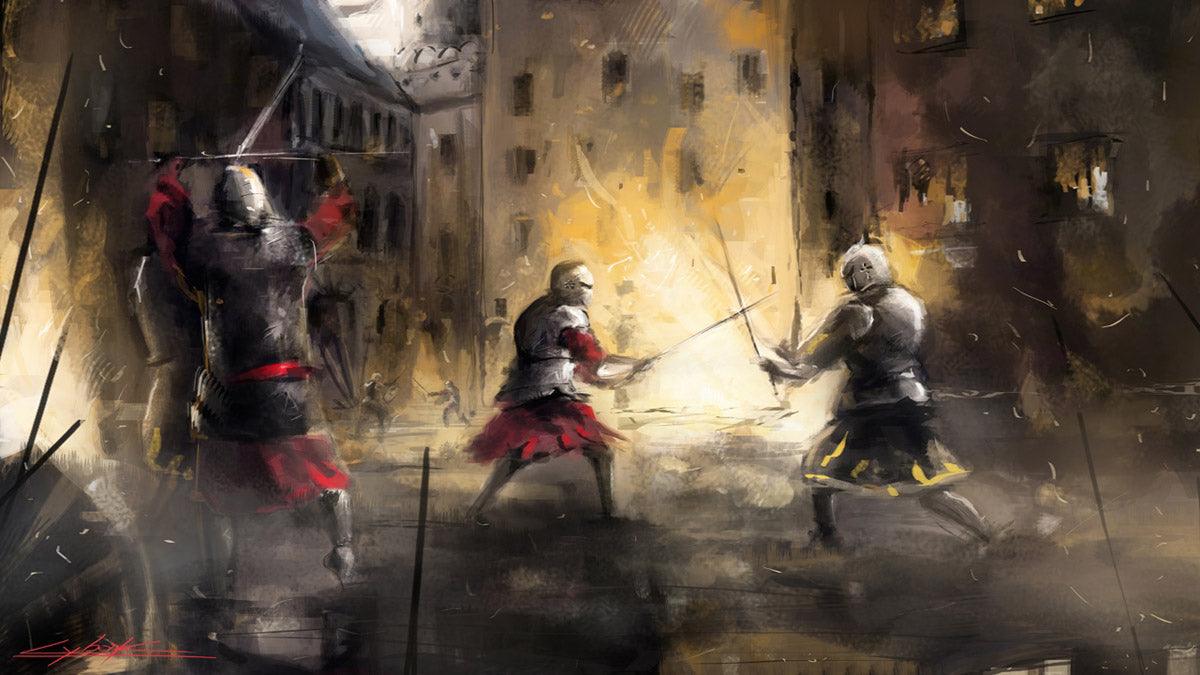This is the first installment in a series I'm writing on knife and swordmaking and the stories that go along with it. Over the years, people have often asked me how I got into swordmaking, or what inspired a certain design. Writing's not my strong suit but I hope you find it interesting and informative. -Barry Dawson
My swordmaking has always been hugely influenced by martial cultures from around the 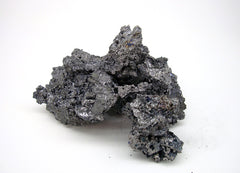 world, and particularly by Japanese swordsmiths. They started with a huge handicap compared to swordsmiths in Europe, just because iron ore as we think of it is next to non-existent in Japan, and the iron sand they used in its place was extremely labor intensive to work. (Think 25 tons of iron sand and charcoal shoveled into a blast furnace over three days and nights to produce one batch of tamahagane, like the one shown left.) And even with all that, it would often produce a much lower quality steel. That they were able to overcome that particular sow’s ear and create so many silk purses is a testament to their skill and dedication.
world, and particularly by Japanese swordsmiths. They started with a huge handicap compared to swordsmiths in Europe, just because iron ore as we think of it is next to non-existent in Japan, and the iron sand they used in its place was extremely labor intensive to work. (Think 25 tons of iron sand and charcoal shoveled into a blast furnace over three days and nights to produce one batch of tamahagane, like the one shown left.) And even with all that, it would often produce a much lower quality steel. That they were able to overcome that particular sow’s ear and create so many silk purses is a testament to their skill and dedication.
I’ve built many Japanese-style pieces over the years, and a few have evolved into regular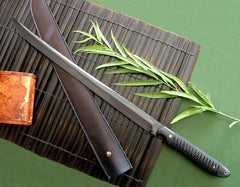 models. The shinobi-style Dark Knight’s no-bs-please-thank-you design was inspired by the slim, straight, easily-concealed weapons that ninja were thought to have used (and often had to make themselves.) I designed the Ronin probably a decade after I’d first taken up sword making, and it is still one of my favorites. It’s based off the samurai sword style of feudal Japan and it’s just freakin’ cool. Hold it and I guarantee you’ll feel like a badass.
models. The shinobi-style Dark Knight’s no-bs-please-thank-you design was inspired by the slim, straight, easily-concealed weapons that ninja were thought to have used (and often had to make themselves.) I designed the Ronin probably a decade after I’d first taken up sword making, and it is still one of my favorites. It’s based off the samurai sword style of feudal Japan and it’s just freakin’ cool. Hold it and I guarantee you’ll feel like a badass.
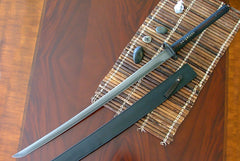 The heart and soul of any good sword is in the blade. Everything else is cream. I chose the best steel I could find, then I spent a lot of time studying traditional Japanese heat-treat techniques and experimenting, learning to recreate and even improve them in my own shop using modern tools and materials. I had to build or modify most of my own equipment, because it just didn’t exist in those days. Today my clay-hardened heat treat is something I’m very proud of, that produces a beautiful, quality blade with a real hamon or “hard line”.
The heart and soul of any good sword is in the blade. Everything else is cream. I chose the best steel I could find, then I spent a lot of time studying traditional Japanese heat-treat techniques and experimenting, learning to recreate and even improve them in my own shop using modern tools and materials. I had to build or modify most of my own equipment, because it just didn’t exist in those days. Today my clay-hardened heat treat is something I’m very proud of, that produces a beautiful, quality blade with a real hamon or “hard line”.
Now, there’s plenty of cheap imitations of hamon on the factory sword market today, 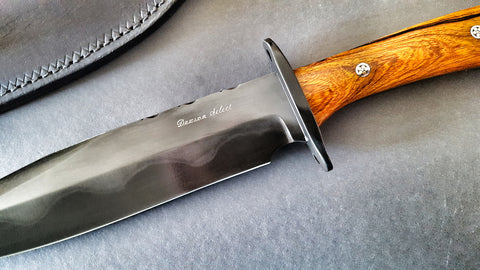 usually achieved by laser-engraving, acid etching or the like. But like file work or scrimshaw, this faux hamon serves no purpose other than to look pretty. A real hamon is certainly beautiful, but more importantly it represents visually the differential hardening of the sword blade. The darker area near the edge is the hardest portion, which allows the sword to hold a nice, sharp edge; then comes the silvery nioi, a thin strand of faintly glittering steel that marks the boundary between the hard edge and the softer spine. The nioi as shown on this Tombstone Bowie, right, is one of the things to look for in a genuine hamon and can't be faked. This type of heat treat allows a sword or knife the flexibility and strength to absorb shock from a blow rather than snapping or breaking.
usually achieved by laser-engraving, acid etching or the like. But like file work or scrimshaw, this faux hamon serves no purpose other than to look pretty. A real hamon is certainly beautiful, but more importantly it represents visually the differential hardening of the sword blade. The darker area near the edge is the hardest portion, which allows the sword to hold a nice, sharp edge; then comes the silvery nioi, a thin strand of faintly glittering steel that marks the boundary between the hard edge and the softer spine. The nioi as shown on this Tombstone Bowie, right, is one of the things to look for in a genuine hamon and can't be faked. This type of heat treat allows a sword or knife the flexibility and strength to absorb shock from a blow rather than snapping or breaking.
 It’s such a completely different operation just trying to grind a long, curved sword compared to a knife, bowie or even a shorter sword that it’s hard to describe. They balance differently, for starters. The longer the blade, the more prone it is to warping and twisting during the heat treat process, so you’ve got to be on it out of the oven like white on rice. All your grinds have to be one long, smooth motion, or you end up with ripples and hollows, and of course the height of the grind has to be the same on both sides. This is surprisingly tricky. The idea can be explained in 5 minutes but can take months or years to master. I call it the “mohawk effect”, from a joke I once heard about a guy who’s shaving in front of the mirror one morning and notices one sideburn is higher than the other. He shortens the opposite side, only to realize that now it’s too short. This continues until, by the time he comes down to breakfast, he’s got a mohawk and a “don’t ask” expression on his face. I had a few swords like that early on that ended up on the scrap pile.
It’s such a completely different operation just trying to grind a long, curved sword compared to a knife, bowie or even a shorter sword that it’s hard to describe. They balance differently, for starters. The longer the blade, the more prone it is to warping and twisting during the heat treat process, so you’ve got to be on it out of the oven like white on rice. All your grinds have to be one long, smooth motion, or you end up with ripples and hollows, and of course the height of the grind has to be the same on both sides. This is surprisingly tricky. The idea can be explained in 5 minutes but can take months or years to master. I call it the “mohawk effect”, from a joke I once heard about a guy who’s shaving in front of the mirror one morning and notices one sideburn is higher than the other. He shortens the opposite side, only to realize that now it’s too short. This continues until, by the time he comes down to breakfast, he’s got a mohawk and a “don’t ask” expression on his face. I had a few swords like that early on that ended up on the scrap pile.
Barry Dawson has been hand-making custom knives and swords for over 40 years. He  has since taught his niece, nephews and great-nephews the art and despite being a cantankerous old guy, somehow manages to work together with them on a daily basis in relative peace and harmony. Unless someone moves his tools.
has since taught his niece, nephews and great-nephews the art and despite being a cantankerous old guy, somehow manages to work together with them on a daily basis in relative peace and harmony. Unless someone moves his tools.


